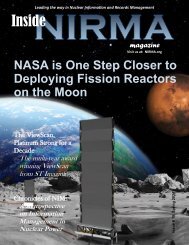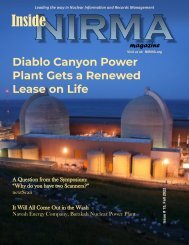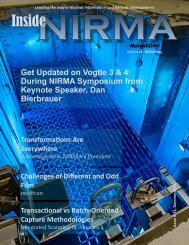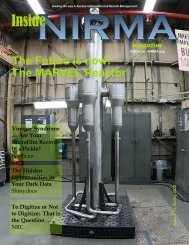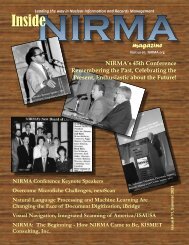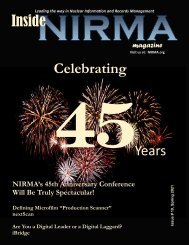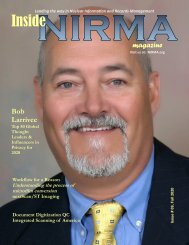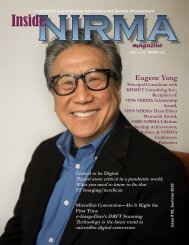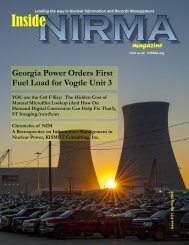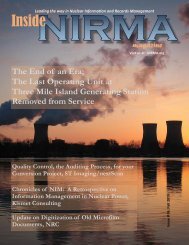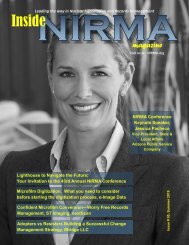Inside NIRMA Magazine Summer 2018 - FINAL
You also want an ePaper? Increase the reach of your titles
YUMPU automatically turns print PDFs into web optimized ePapers that Google loves.
Quarter of U.S.<br />
Nuclear Fleet at<br />
Risk for Closure<br />
Lawmakers pass pro-Yucca<br />
Mountain bill<br />
Over a quarter of US nuclear fleet<br />
not covering costs: BNEF<br />
DOE Congress Recognize Nuclear’s<br />
Clean Uses Beyond Electricity<br />
More than a quarter of U.S. nuclear<br />
power plants do not earn enough<br />
revenue to cover operating costs,<br />
according to a report published by<br />
Bloomberg New Energy Finance<br />
(BNEF) on May 15.<br />
The at-risk nuclear sites represent a<br />
total generation capacity of 32.5 GW,<br />
BNEF analysts Nicholas Steckler and<br />
Chris Gadomski, said in their report.<br />
The total revenue gap for these<br />
projects is estimated at around $1.3<br />
billion per year, the analysts said.<br />
Nuclear operators face continuing<br />
pressure from low wholesale electricity<br />
prices, driven by low gas prices and<br />
rising renewable energy capacity.<br />
Last month, the U.S. state of New<br />
Jersey passed bills which provide<br />
nuclear power generators with price<br />
support and sets a target of 50%<br />
renewable energy by 2030. New<br />
Jersey's nuclear subsidies follow on<br />
from similar support mechanisms<br />
introduced in the states of New York<br />
and Illinois.<br />
Nuclear operators have already<br />
announced plans to close 11 GW of<br />
nuclear power capacity by 2025,<br />
according to the U.S. Energy<br />
Information Administration (EIA).<br />
The EIA predicts additional unplanned<br />
retirements will reduce total U.S.<br />
nuclear generating capacity from 99<br />
GW in 2017 to 79 GW by 2050, in its<br />
latest reference case scenario.<br />
Article reprinted with permission of<br />
Nuclear Energy <strong>Inside</strong>r.<br />
Read full article here.<br />
Last week the federal government<br />
took great strides—both<br />
internationally and here at home—<br />
to recognize and promote nuclear<br />
energy’s most promising attributes<br />
of emission-free electricity<br />
generation, reliability and resiliency.<br />
Nearly every country in the world is<br />
currently engaged in efforts to<br />
reduce their carbon emissions while<br />
growing their economies. Currently,<br />
449 reactors in 30 countries provide<br />
34 percent of the world’s clean<br />
electricity—that figure is 56 percent<br />
in the United States. However,<br />
many discussions about increasing<br />
the use of clean energy continue to<br />
exclude nuclear from consideration.<br />
At a clean energy ministerial-level<br />
meeting in Denmark, U.S. Deputy<br />
Secretary of Energy Dan Brouillette<br />
joined Canada and Japan in<br />
launching a global initiative that will<br />
start to redress that imbalance.<br />
The Nuclear Innovation: Clean<br />
Energy (NICE) Future initiative’s<br />
mission is to highlight the value of<br />
nuclear energy as a clean, reliable<br />
and resilient energy source. Other<br />
countries participating in the<br />
initiative include Russia, South<br />
Africa, the United Arab Emirates<br />
and the United Kingdom, and more<br />
than a dozen countries have<br />
expressed interest in joining.<br />
NICE “will make sure nuclear has a<br />
seat at the table during discussions<br />
about innovation and advanced clean<br />
energy systems of the future,”<br />
Brouillette said at the meeting.<br />
As Secretary Perry has stated, we don’t<br />
have to choose between boosting our economy<br />
or protecting our environment. We can<br />
achieve both.<br />
— Dan Brouillette, U.S. Deputy<br />
Secretary of Energy<br />
The initiative promotes the use of<br />
innovative nuclear systems that will<br />
play a critical role in worldwide<br />
decarbonization. These can be<br />
applied to electric and nonelectric<br />
uses, such as desalination, industrial<br />
process heat, systems that integrate<br />
baseload nuclear and variable<br />
renewable sources, flexible electricity<br />
grids, hydrogen production and<br />
energy storage. The initiative also will<br />
focus on the development of small<br />
modular reactors and advanced<br />
reactors.<br />
“Nuclear power is finally being<br />
sufficiently recognized as the<br />
workhorse of the global clean energy<br />
sector,” said ClearPath Foundation<br />
Executive Director Rich Powell, who<br />
attended the meeting.<br />
Article reprinted with permission of<br />
Nuclear Energy Institute (NEI). Read<br />
full article here.<br />
<strong>Inside</strong> <strong>NIRMA</strong> <strong>NIRMA</strong>.org <strong>Summer</strong> <strong>2018</strong> 25



